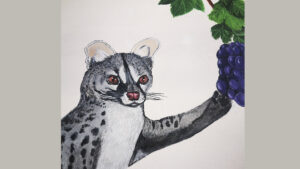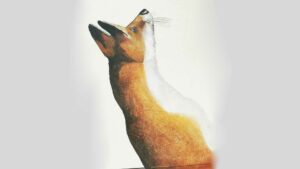13. The look
The look of a wildcat
Wildcat in his watchtower
About these mammals
Some curiosities about these mammals
The European wildcat (Felis silvestris) is a carnivorous mammal of the family Felidae, it has similarities with the domestic cats known as Roman cats, but if we look closely we can detect the most notable differences which are:
Bobcats have a much thicker and larger skull and neck, their tail is also much thicker, bobcats never have spots, only lines, with one line running down their back. The hair of wildcats is longer and denser, and their whiskers are thicker and always drooping downwards. The colour of their coat is always grey with black stripes. White tufts protrude from their ears.
European cats are solitary animals with nocturnal or crepuscular habits; in winter they can be seen during the day on occasion. Males roam more than females, which tend to stay in a smaller territory, and at night both move about to hunt in their home range. One of their most developed senses is hearing and sight, which they use for hunting. They are extremely silent animals that hunt by stalking and jump on their prey, grabbing them with their claws, which are retractable. They kill smaller prey by biting them on the nape of the neck, while larger prey are killed by suffocation with a bite on the neck. It sometimes hides its prey if it senses a threat by burying them in leaves or in a hollow, although it usually eats them as soon as it hunts them. Its prey are especially rodents, mice, rats, dormice and voles, but it also preys on small birds, amphibians, reptiles and even insects.
They are very territorial, especially females during the breeding season in order to protect their litter. The males associate in brotherhoods, which they join after a year of confrontations with the older males and proving that they are strong; if they are not, they must leave the territory.
Wildcats can live up to 12 years in the wild and 15 in captivity, they are polygamous species and the females have more than one partner, the heat is from February to March, only once a year, the cubs are born after 65 days of gestation normally in a number of 3 to 4 of which one or none usually manage to reach adulthood, they will spend three to four months with their mother until they become independent, they will not be sexually active until they are 10 months old. They are eminently forest animals, which are not found near human settlements or in desert or steppe areas. They require settled wooded areas with dens, hollows or dense undergrowth that they can use for burrowing. They mark their territories with their droppings and urine.
The wildcat’s natural enemies are the golden eagle, which it can confront and even kill, and it can also be preyed upon by the wolf and the lynx, as they are predators facing each other for prey. But its main threat is man, it has been harassed a lot with the false belief that they prey on poultry, when in fact they are very elusive to humans and it is the domestic cats and hybrids that are the main problem for these poultry, another threat is the hybridisation that occurs between the wildcat and the domestic cat that makes the species cease to exist to give rise to mixtures that are not pure.
How it was done
Discover how this Painting was made
The cat was made during 2 weeks, it was the first time I painted a mammal which was a very special challenge, it was also very important to make the expression as real as possible and to capture the depth and beauty of these unknown animals, it was a precious work to observe how this beautiful specimen appeared little by little and it has been very attractive for the people who pass by in the street, even the pets are wary when they see those eyes that look at them with serenity and aplomb.
ROUTE OF PAINTINGS
The Painting Route through Vélez-Blanco continues
This painting is located on the façade of a neighbour of Vélez Blanco, it is next to the entrance door of the house and its dimensions are 0,72 m wide and 1,42 m high. You can see other works by following our street route in Vélez Blanco.
BOOKINGS
Book your exclusive stay at The House of the Birds
You will discover a different kind of rural accommodation, with all the comforts of a completely restored house but with a rural feel. With fireplace, wine cellar, games room, table football room, spacious lounge, comfortable bathrooms, fully equipped kitchen and in the heart of a unique village with its beauty as is Vélez Blanco.



